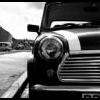you can use your own vehicle for the test however read through the following on the
DSA/directGov website
or alternatively
Category B - cars and vans
A car or van presented for test must be:
* a four wheeled vehicle of no more than 3,500 kilograms (kg) maximum authorised mass (MAM)
* capable of a speed of at least 100 kilometres per hour (km/h) or 62.5 miles per hour (mph)
The car or van must also be fitted with:
* a seatbelt for the examiner
* a passenger head restraint, which needn't be adjustable but must be fitted as an integral part of the seat - 'slip on' type head restraints aren't permitted
* an interior mirror for the examiner's use
* L-plates displayed on the front and rear of the vehicle but not interfering with the driver's or examiner's view
* a speedometer that measures speed in mph and km/h
If the vehicle presented for test is fitted with an electronic handbrake it must be capable of being manually overidden and operated as a conventional handbrake.
The vehicle must be legal and roadworthy and have no warning lights showing, eg the airbag warning light.
Suitability of vehicles for Category B tests
Most hatchbacks, saloons and estate cars are suitable for the driving test, but some models with good forward vision have large blind spots to the rear, giving examiners problems with observation.
Panel vans also present problems with vision and are often unsuitable for test.
Vehicles supplied by motor manufacturers have been through the type approval process. This approval concentrates on vehicles from a driver’s point of view and does not necessarily make the vehicle suitable for a driving test.
Vehicles for test must allow examiners all round vision to see approaching vehicles. This is particularly important when the car is at an angle to other vehicles during reversing manoeuvres and when emerging at a junction with the vehicle at an angle to the major road.
The Toyota iQ has been risk-assessed and is unsuitable for the practical driving test.
Vehicle recalls and safety notices
Vehicles are sometimes not suitable for a practical driving test because they are subject to a manufacturer recall, or because they have a fault that requires manufacturer or dealer correction.
In these circumstances, these vehicles are not suitable for a practical driving test unless the candidate can provide documentary evidence from a dealer, or the vehicle manufacturer, to prove that their test vehicle meets one of the criteria below:
* the recall work has been carried out
* the vehicle has been checked and no work is necessary
* the vehicle is exempt from the recall work
* Check to see if the vehicle you intend to use on a driving test is affected
Category B + E
Car and trailer test vehicles must be:
* fitted with externally mounted, nearside and offside mirrors for use by the examiner or any person supervising the test
* an unladen category B vehicle towing a suitably braked, unladen trailer of at least one tonne MAM - the examiner may ask for evidence of the trailer MAM eg the manufacturer's plate
* fitted with an audible or visual device to indicate correct operation of the trailer indicators
All vehicle combinations must operate on appropriate brakes and utilise a coupling arrangement suitable for the weight.
The cargo compartment of the trailer must consist of a closed box body which is at least as wide and as high as the towing vehicle. The view to the rear should only be possible by use of the external rear-view mirrors of the towing vehicle.
(taken from above site)
